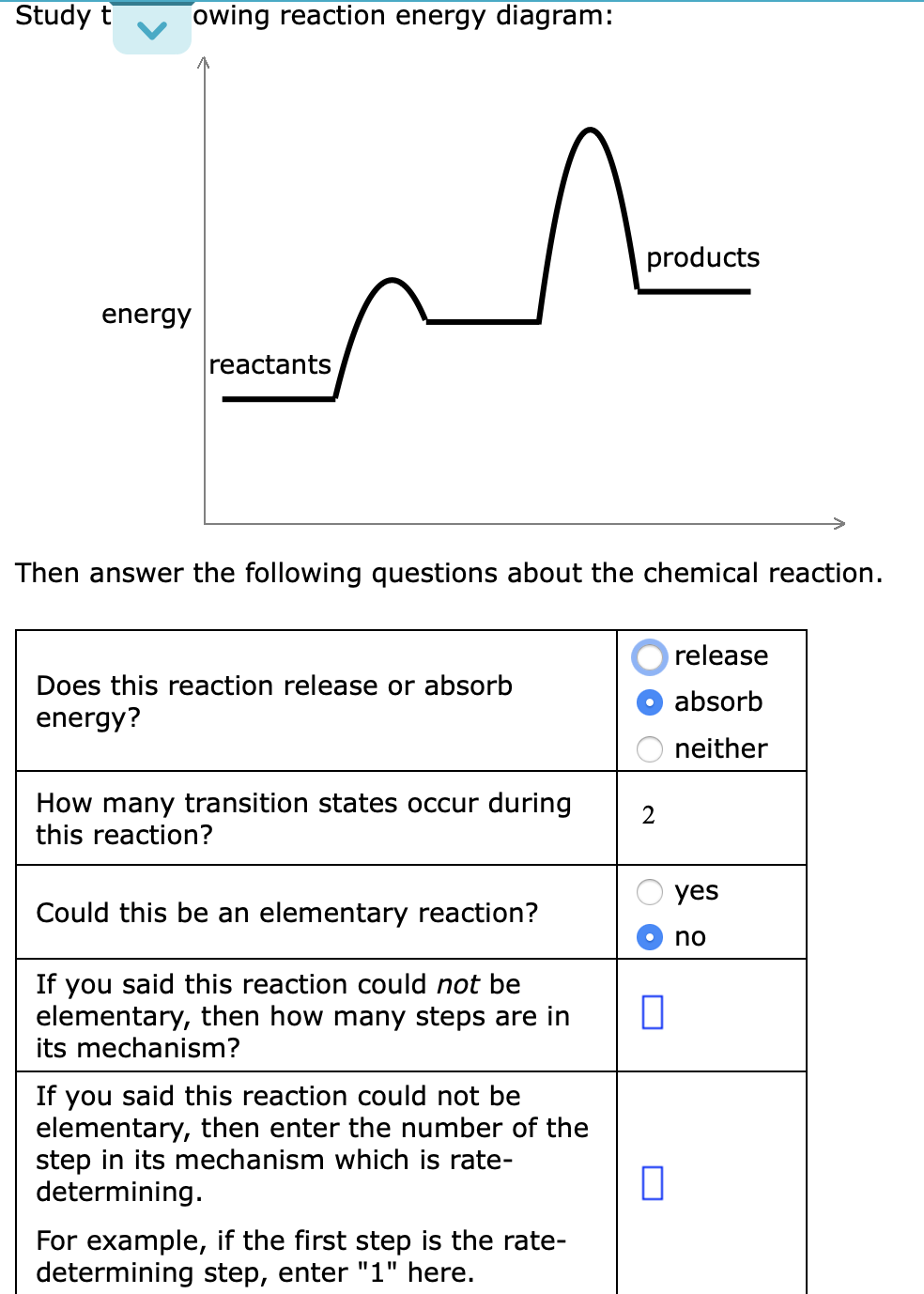Study t Owing reaction energy diagram: products energy reactants Then answer the following questions about the chemical reacti release Does this reaction release or absorb absorb energy? neither How many transition states occur during this reaction? yes Could this be an elementary reaction? no If you said this reaction could not be elementary, then how many steps are in its mechanism? If you said this reaction could not be elementary, then enter the number of the step in its mechanism which is rate- determining. For example, if the first step is the rate- determining step, enter "1" here.
Study t Owing reaction energy diagram: products energy reactants Then answer the following questions about the chemical reacti release Does this reaction release or absorb absorb energy? neither How many transition states occur during this reaction? yes Could this be an elementary reaction? no If you said this reaction could not be elementary, then how many steps are in its mechanism? If you said this reaction could not be elementary, then enter the number of the step in its mechanism which is rate- determining. For example, if the first step is the rate- determining step, enter "1" here.
Chemistry for Today: General, Organic, and Biochemistry
9th Edition
ISBN:9781305960060
Author:Spencer L. Seager, Michael R. Slabaugh, Maren S. Hansen
Publisher:Spencer L. Seager, Michael R. Slabaugh, Maren S. Hansen
Chapter8: Reaction Rates And Equilibrium
Section: Chapter Questions
Problem 8.20E: In each of the following, which reaction mechanism assumption is apparently being violated? Explain...
Related questions
Question
100%

Transcribed Image Text:Study t
owing reaction energy diagram:
products
energy
reactants
Then answer the following questions about the chemical reaction.
release
Does this reaction release or absorb
absorb
energy?
neither
How many transition states occur during
this reaction?
2
yes
Could this be an elementary reaction?
no
If you said this reaction could not be
elementary, then how many steps are in
its mechanism?
If you said this reaction could not be
elementary, then enter the number of the
step in its mechanism which is rate-
determining.
For example, if the first step is the rate-
determining step, enter "1" here.
Expert Solution
This question has been solved!
Explore an expertly crafted, step-by-step solution for a thorough understanding of key concepts.
This is a popular solution!
Trending now
This is a popular solution!
Step by step
Solved in 6 steps with 4 images

Knowledge Booster
Learn more about
Need a deep-dive on the concept behind this application? Look no further. Learn more about this topic, chemistry and related others by exploring similar questions and additional content below.Recommended textbooks for you

Chemistry for Today: General, Organic, and Bioche…
Chemistry
ISBN:
9781305960060
Author:
Spencer L. Seager, Michael R. Slabaugh, Maren S. Hansen
Publisher:
Cengage Learning


Chemistry: An Atoms First Approach
Chemistry
ISBN:
9781305079243
Author:
Steven S. Zumdahl, Susan A. Zumdahl
Publisher:
Cengage Learning

Chemistry for Today: General, Organic, and Bioche…
Chemistry
ISBN:
9781305960060
Author:
Spencer L. Seager, Michael R. Slabaugh, Maren S. Hansen
Publisher:
Cengage Learning


Chemistry: An Atoms First Approach
Chemistry
ISBN:
9781305079243
Author:
Steven S. Zumdahl, Susan A. Zumdahl
Publisher:
Cengage Learning

Chemistry & Chemical Reactivity
Chemistry
ISBN:
9781133949640
Author:
John C. Kotz, Paul M. Treichel, John Townsend, David Treichel
Publisher:
Cengage Learning

Chemistry & Chemical Reactivity
Chemistry
ISBN:
9781337399074
Author:
John C. Kotz, Paul M. Treichel, John Townsend, David Treichel
Publisher:
Cengage Learning

Chemistry for Engineering Students
Chemistry
ISBN:
9781337398909
Author:
Lawrence S. Brown, Tom Holme
Publisher:
Cengage Learning